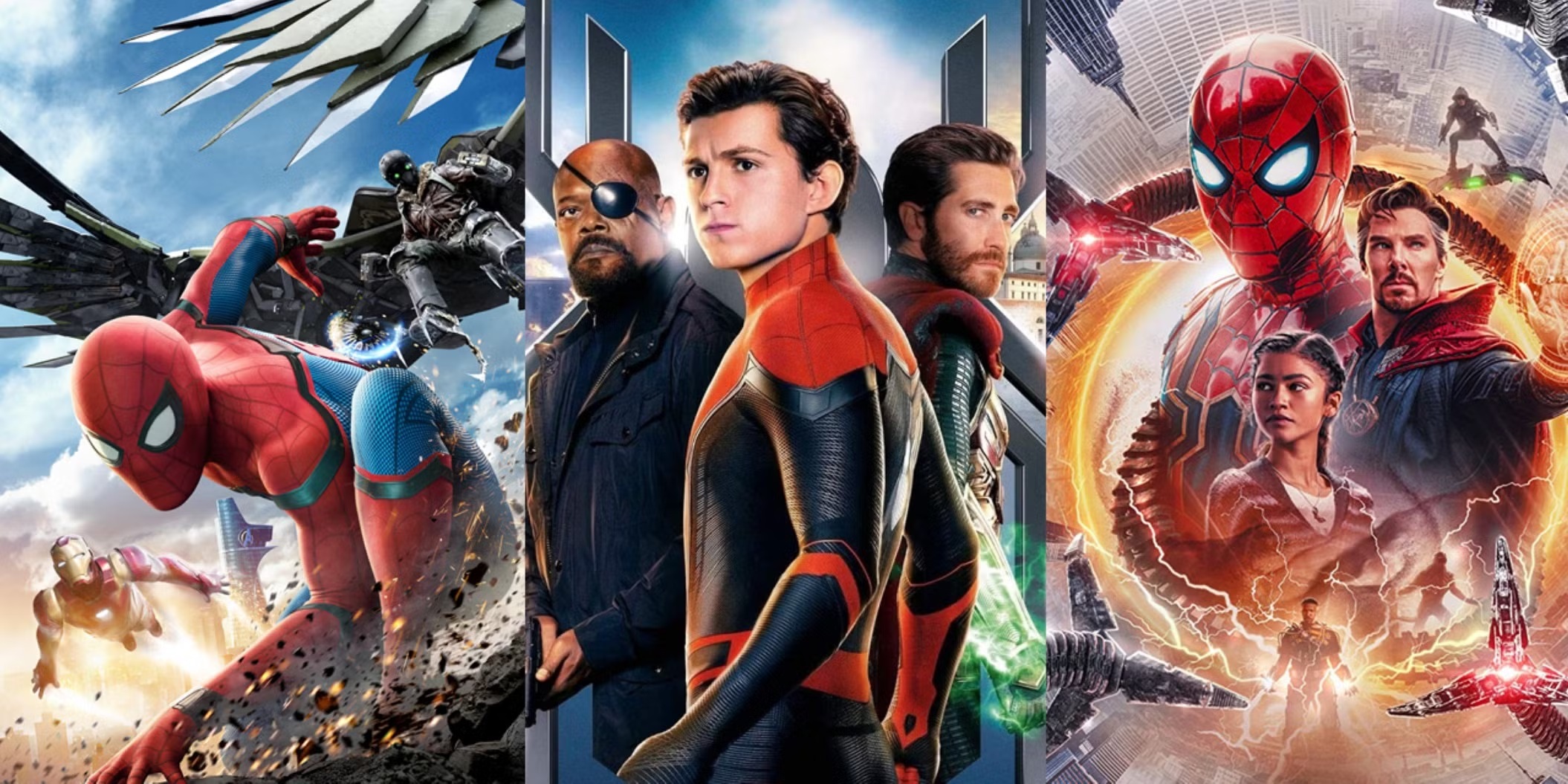This review shares my thoughts on the Spider-Man trilogy: Homecoming, Far From Home, and No Way Home. More precisely, it’s about Peter Parker, portrayed by Tom Holland. What captivates me isn’t this Peter’s powers. Personally, I find the Spider-Men of Tobey Maguire and Andrew Garfield faced tougher foes—stronger, craftier, and knowledgeable about Spider-Man—while battling alone, without mentors or high-tech gear from organizations, making their resilience stand out more.
What draws me to this trilogy’s Spider-Man is the coming-of-age journey of a teenager facing life’s turning points. Even if you’re not into superhero universes, if you care about the psychology and traits of youth, don’t miss Tom Holland’s Spider-Man.
Part 1: Homecoming
In Homecoming, Spider-Man is a high schooler eagerly awaiting new missions from Tony Stark (Iron Man). Like his peers, he’s brimming with energy and time but lacks experience, stumbling into trouble while chasing criminals. Though he scores minor wins, the damage he causes often outweighs them.
Tony Stark gets fed up and confiscates Peter’s advanced suit. This moment highlights a generational gap: adults know more than teens but not everything. Sometimes they forget this, dismissing and dictating instead of listening. This might partly explain why adolescence is labeled “rebellious.” Feeling stifled, disrespected, and ordered around, teens turn to extremes. Yet, with care and conversation, puberty isn’t the chaos we assume for some.
Spider-Man is that kind of kid. Misunderstood, scolded, and slightly belittled, he still acts on what he believes is good, avoiding defiance or negativity. When adults feel challenged, they deny kids equal footing and impose control. Parents, beware if your child resists—it’s a sign they feel undervalued or improperly respected.
But without guidance, this pubescent Spider-Man could turn his zeal and powers into disaster. If held accountable for his rash, thoughtless actions, he’d spend less time hero-ing and more working to pay off damages—like nearly sinking a ferry with passengers or trashing Stark’s plane in a chase.
His independence is charming, but without listening skills or reflection, this budding hero risks becoming a laughingstock. I doubt any dangerous villain surrenders because they’re too busy chuckling at a hero’s naivety.
In battle, small mistakes can kill. Teens aiming to be heroes need diligent training, patient learning, and seasoned mentors—not reckless justice. In reality, justice and evil aren’t textbook-simple. Even Spider-Man nearly dies—imagine us, without powers or protagonist luck.
Part 2: Far From Home
In Far From Home, Spider-Man dials back his bravado, no longer eager to play hero. More mature, he just wants a normal student life. But fate (or directors and fans) thrusts him against Mysterio.
Quirky like most villains, Mysterio could’ve been a hero like Batman or Iron Man. He reads people well, leverages team support and tech, and excels at strategy. On the battlefield, I’d argue he’s Spider-Man’s toughest foe in this universe. Compared to Peter’s youthful impulsiveness, Mysterio’s a cunning fox—outsmarting even Nick Fury.
The message for teens here: “choose your friends wisely” and don’t over-trust tech. Desperate to offload Tony’s burden, Peter misjudges and hands Mysterio glasses controlling a high-tech system. This battle-hardened but life-inexperienced hero doesn’t foresee that true threats don’t always announce themselves.
The glasses don’t care about their owner’s morals. Tech is power that, in immature hands, corrupts. Spider-Man survives thanks to protagonist aura after falling into Mysterio’s perfect trap. He nearly makes headlines crashing into a train—his “teen” death chalked up to school stress, adult conflicts, or romance woes.
Peter beating Mysterio feels odd. Luck favors our Spider-Man; the villain’s just unlucky. Skill-wise, I struggle to credit Peter the win. Mysterio proves this later with a backup plan (something Peter never bothers with, banking on luck, Avengers rescues, or winging it).
Post-death, Mysterio strikes via tech, exposing Spider-Man as Peter Parker, turning media into his weapon. In Part 3, you’ll see he succeeds, wiping Peter from everyone’s memory.
Part 3: No Way Home
Identity exposed, our Spider-Man faces a mess. He seeks Dr. Strange’s help—not a tech guru like Tony, but a mystic.
Science or magic, nothing’s foolproof. Had Peter swapped swinging for studying, he might’ve spoken clearly and not interrupted Dr. Strange’s ritual. A basic lesson: even heroes need education, starting with fundamentals. Peter excels in science, his quick reflexes showing sharp uptake. But quantum physics or multiverse smarts mean little if he can’t express himself—except when trapping Dr. Strange in a mirror world with math (read more, Spider-Man).
Villains from other universes arrive. As usual, Peter creates problems instead of solving them. His good intent to save them lacks insight into their nature. Spider-Man’s beauty is trusting others’ goodness, but this idealism detaches him from reality. Villains aren’t randomly evil or moody—they’ve deep moral or cognitive flaws, built over time. Forcing instant redemption is beyond him. It’s like grabbing a scorpion to preach against stinging, deluding yourself it’ll spare you for your kindness.
Dr. Strange warns the universe has its rules, not bending to human whims when people don’t even know what they truly want (did he read some law of attraction book?). Like a test, this naive hero crosses lines and pays with his normal life. In other universes, Spider-Man loses Uncle Ben or MJ. “With great power comes great responsibility” holds across realms—like Dr. Strange loving his girlfriend in every one.
The humane ending—only kind Aunt May dies while villains get a chance to reform (imagine them penning redemption memoirs, raking in billions, inspiring talks, then waking hungover on a yacht, realizing their past folly)—shifts Peter’s life entirely.
I love the near-end scene where he enters a bakery, planning to jog Ned and MJ’s memories. It’s romantic—snow, Christmas gifts. Our Spider-Man, tidied up, script ready (progress!), steps in. He observes (more growth), reflects (a mature sign), and chooses wisely to avoid new messes (he’s truly grown). His talk with Happy at May’s grave shifts too—no rambling, just urging self-care.
Maturity’s a tough road with losses, for heroes and us alike. In life, dodging hardship with endless “healing” might push that day far off.
In Place of a Conclusion
Last week, a student returned from a trip with a Spider-Man Lego set for his desk. He lights up talking about it. I appreciate the creators crafting a cinematic universe where heroes inspire resilience and goodness.
In the future, I hope creators team with educators so teen content isn’t just fun but carries lessons—not textbook preaching or illogical leaps, with guidance. Rare as it is, I’d hate for kids to test spider bites hoping to transform, as some news reports claim.
Balancing humor, joy, and practical wisdom isn’t easy. Writing this is simpler than filmmaking. But in this era, that noble effort matters. Kids and teens learn more from entertainment—especially online—than school. A teen hero mirroring their thoughts and actions is a calculated draw, and Tom Holland nails this distinct Spider-Man. Digging deeper into Peter’s growth lessons, easing up on flashy effects, and showing victory through effort—not just powers—while striving to improve himself could make Spider-Man even more memorable.
This review reflects my educational lens, sometimes speculative, using personal views to unpack subjective takes on the trilogy. Watch it yourself for the full experience—it’s a series for all ages, never dull.















